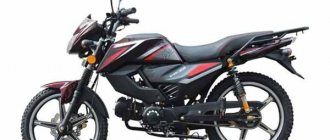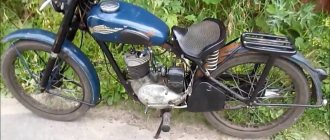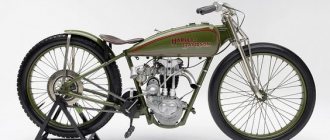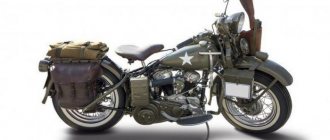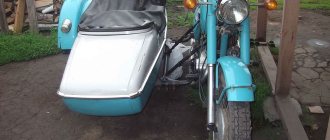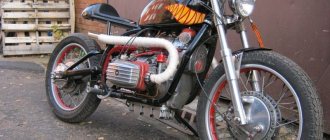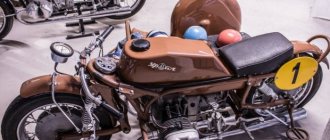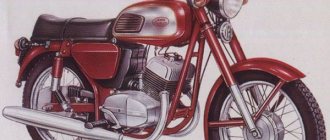9 Soviet scooters with European roots (9 photos)
Author: Yugansk
24 January 2021 21:01
Community: Moto
Tags: USSR Photos. interesting scooters motorcycles
11593
9
A scooter is a compact motorcycle with a comfortable seating position, in which your legs are not on either side of the “iron horse,” but comfortably, as if you were a passenger in a car. And the seat itself is more comfortable.
1.
0
See all photos in the gallery
"Tula T-200" (1957-1961). The first Soviet scooter was produced at the Tula Machine-Building Plant named after Ryabikov and was an unlicensed copy of the German Glas Goggo scooter (1951-1957). The T-200 was the heaviest Soviet scooter. It weighed 140 kg, which made it almost impossible to lift and differed little from a motorcycle. It is interesting that although Glas Goggo was finished before production of the T-200 began, Germany categorically blocked the import of plagiarism into the Western European market. In the USSR there were two competing factories for the production of scooters - the Tula Machine-Building Plant named after Ryabikov and the Vyatsko-Polyansky Machine-Building Plant. Initially, they produced unlicensed copies of foreign models - German and Italian, respectively, but then switched to their own designs. In this material we will only talk about passenger scooters.
2.
0
"Vyatka VP-150" (1957-1966). The scooter from the Vyatsko-Polyansky Machine-Building Plant, which went on sale simultaneously with Tula, is an unlicensed copy of the Italian Vespa 150GS. This model was more advanced than the Tula one, weighed only 108 kg and was eventually produced in a “circulation” of 290,467 copies. It’s funny, but the model retained the Italian bolt standards (13 mm), and keys of this size were not sold in the USSR - they could only be obtained as part of the scooter kit. The main thing was not to lose.
×
3.
0
"Tula T-200M" (1961-1967). An upgraded version of the Tula T-200. The changes were mainly cosmetic (fork, nameplates), plus several technological changes, for example, the air filter.
4.
0
"Vyatka V-150M" (1965-1973). An improved version of the Vyatka VP-150. It received a new body, many new structural elements, a more powerful 6-horsepower engine, but at the same time “heavier” up to 120 kg. In fact, it was the first scooter of a Soviet, not borrowed design.
5.
0
"Tourist" (1968-1971). A scooter that replaced the outdated Tula T-200. Significantly more modern, with an improved design and, most importantly, Tulsky’s own full-fledged development, it gained significantly higher popularity and was already seriously competing with Vyatka. The downside is still being overweight.
6.
0
"Tourist-M" (1971-1978). An improved version of the "Tourist" with a new 12-horsepower engine and a number of technical bonuses. In particular, they corrected many of the shortcomings of the original, which the owners had previously corrected with their own hands. For example, the sound signal was moved from under the wing to the steering column (under the wing it often suffered from dirt and moisture).
7.
0
"Vyatka-Electron" (1974-1979). In fact, this is just a modification of the Vyatka V-150M model with an electronic ignition system, which gave the scooter its name. A small facelift was also carried out - front fender, seat, steering wheel, reflectors. "Electron" became the last scooter of the Vyatka plant.
8.
0
"Tulitsa" (1978-1986). One of the classic Soviet scooters, a model of the Tula Machine-Building Plant, which replaced the Turist-M on the assembly line. It is interesting that “Tourist” was originally planned to be called “Tulitsa”, but was renamed, and only this generation received the original name. In principle, the differences between Tulitsa and Tourist-M were at the same level as the differences between Tourist-M and Tourist. That is, in essence, a modification.
9.
0
"Tulitsa-2" (1986-1989). The latest modification of the Tula scooter with a 14.5 hp engine. and weighing 134 kg.
Source:
Related links:
- 15 things from the times of the USSR that many people collect dust on the mezzanine
- Do you remember? 18 eloquent photos from the dashing 90s
- Through the waves of memory: 15 household items from the times of the USSR, which have long been replaced
- Toilet paper in the USSR: how residents of the Soviet Union were weaned from using “newspaper”
- Why did the Khrushchev and Stalin buildings have windows in the bathrooms?
subscribe to the Moto community
Tags: USSR Photos. interesting scooters motorcycles
Do you like to remember how things were before? Join us, let's feel nostalgic together:
87 6 81
Liked
81 2
18
Partner news
Top 5 scooters from the USSR
Hello everyone, Pitbike Club is here!
Soviet motor scooters appeared in the post-war period and were in great demand among citizens. The external similarity with foreign copies was explained simply: at the Vyatsko-Polyansky plant and at the plant in Tula, scooters from Germany, Italy and other European countries were simply copied.
Tula T-200
This is an unlicensed version of Goggo-roller, imported from Germany. For its time, the scooter was innovative, progressive and simply the first scooter in the USSR.
Of course there were some downsides. Weighing 155 kg, the power unit of this Pepelats developed only 8 horses. It was very little, and even with a 4-speed manual. The bike handled poorly, and the space frame suffered greatly from time to time. The scooter was produced since 1957, and in 1961 there was a restyling with a decrease in total weight and an increase in power.
Interesting fact: The Tula T-200 was produced in a version with a sidecar!
Vyatka VP-150
Another unlicensed copy, but this time the “donor” is the Italian Vespa 150 GS. It was produced since 1957 and was in great demand among the population.
The 2-stroke engine accelerated the scooter to 60 km/h in just 13 seconds. The indicator is far from cosmic, but it should be taken into account that it is not easy to accelerate a 108-kilogram scooter with a 1-cylinder engine with a power of 5.5 horses, coupled with a 3-speed gearbox.
Since 1965, the Vyatka VP-150 scooter has been improved. This is how the Vyatka V-150M was born. In the restyled model, power was increased, the body was redesigned and the frame was strengthened, but the weight increased to 120 kg.
This model was not in demand as the market began to fill with foreign scooters.
Tourist
It entered the production line in 1968 and, with restyling in 1971, was produced until 1979. By nature, the Tourist is an improved Tula.
The tourist had excellent characteristics - 199 cubic meters, 11 horsepower, 4-speed manual transmission and a top speed of 85 km/h.
A nice feature of the Tourist is a large number of glove compartments and a lever fork. The scooter boasts of its reliability and unpretentiousness!
The Little Humpbacked Horse
A prototype of a Soviet motor scooter, which was ahead of its time and did not make it into the series.
The first scooter prototype rolled off the assembly line in the mid-60s, and already in 1969 the project was postponed.
And the scooter had 32.5 horses and 16-inch off-road wheels!
According to the test results, it handled well and was very reliable.
Ant (TGA-200)
The most popular scooter on the Soviet market! Ant's sales accounted for up to 84% of all scooter sales. This was explained by the fact that Ant was the only available truck.
Its carrying capacity was up to 350 kg, but it carried more. Despite the fact that the power unit was only 170 cc.
There were also examples with a cabin!
Thank you for your attention. We hope that our review was interesting for you!
"IZH-49"
"IZH-49" is a middle-class road motorcycle, designed for riding on any roads of the Fatherland - both alone and with a passenger. Produced by the Izhevsk Machine-Building Plant from 1951 to 1958. Note that its modification was available in the form of a side stroller. Reliable, tenacious, adapted to any conditions and very sonorous (its growl in the USSR was as popular as the roar of Harleys in the USA) - the IZH-49 is still found on the roads of the CIS countries today.
"M-72"
It was produced in large series from 1941 to 1960 at factories in Moscow, Gorky, Irbit, Leningrad and Kyiv. Initially intended exclusively for military needs, the motorcycle did not go on sale until the mid-50s. Each M-72 carried small arms, so according to some classifications it was listed as an “armored vehicle.” More than 8,500 vehicles were produced. It was produced both with a stroller and in a single version. And the motorcycle was made on the basis of the German BMW R71 motorcycle. After the end of the war, vehicles fell into the ranks of the police, becoming the main transport of law enforcement officers. And since 1954, ordinary citizens could buy such “horses” for themselves.
Cargo scooters from the USSR02/25/2021
During the Soviet Union, scooters were considered a comfortable means of transport. Many people could buy it for just two salaries. Cargo scooters were especially in demand in rural areas. At that time, scooters were produced at two factories: the Tula Machine-Building Plant and the Vyatsko-Polyansky Plant, which was located in the Kirov region.
Cargo scooters of the USSR.
The MG-150 cargo scooter was produced at the Kirov plant. The steering column, fairing, 4.5 horsepower engine and three-speed gearbox were taken from the already famous Vyatka. Although the arrangement of components and assemblies was completely different. The MG-150 weighed 285 kg, but could carry a load of up to 250 kg. At the same time, reach a speed of about 35 km/h. The last cargo scooter was released in 1967. During the entire production period, about 75 thousand were produced.
TG-200 scooter from Tula manufacturer. Production started in 1957. In terms of its carrying capacity, the scooter is identical to the “Vyatka”, but in its power characteristics it surpasses it. The TG-200 was equipped with a 7.5 horsepower engine and could develop power up to 50 km/h. Equipped with a 4-speed gearbox. A few years later, the equipment was updated, the engine power was increased, but the weight of the scooter itself was reduced.
TGA-200 "Ant" was also produced at the Tula Machine-Building Plant. A push-type suspension was used, thanks to which the handling was better. The vehicle's power unit had a power of up to 11 forces; the scooter could reach speeds of more than 50 km/h. The weight of the vehicle is 240 kg.
Over time, cargo scooters have undergone major changes. Thanks to the changes, the load capacity was increased to 360 kg. A new Ant-2M-01 has appeared. There were no significant external changes, only new direction indicators were installed. At that time, the dashboard of the Ant cargo scooter had a speedometer and four lights. The green light indicates that the gearbox is in neutral, the red light indicates the battery is charging, the blue light indicates high beam, and the orange light indicates high beam.
In the 80s, the Tula Machine-Building Plant planned to produce the Ant-3 scooter with a cabin. The advantage over other equipment was the presence of car-type steering, the engine was located at the rear, and the suspension was dependent. But only two prototypes were produced; it did not reach mass production. But after the collapse of the USSR, the demand for scooters began to decline rapidly. Factories had to completely abandon their production. Now scooters can be seen in a museum in the Tula region. There are many vehicles on display, some of which have survived to this day only in a single copy.
"Ural M-62"
Soviet heavy motorcycle with sidecar. Produced by Irbitsky Motorcycle) from 1961 to 1965. Was different:
- -increased engine power – 28 “horses”;
- -upgraded gearbox – gear clutches;
- - it had increased suspension travel;
- -changed shape of the front fork casings. Due to this, the M-62 with a 255-kilogram load easily accelerated to 95 km/h, and “ate” only 6 liters per 100 km. Like the M-72, it was most often seen in the form of police transport.

